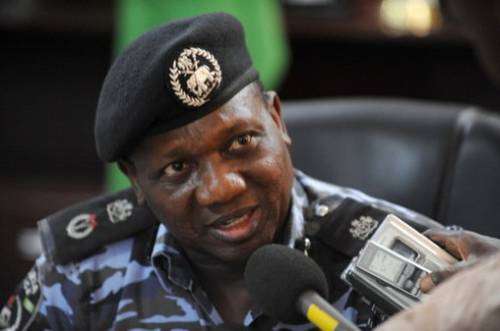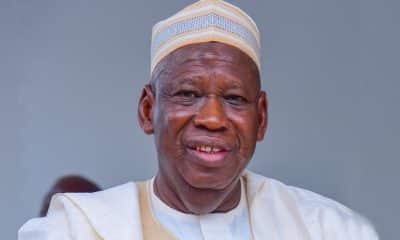Nigeria News
Fact Check: IGP’s ‘Transmission’ Video Was Not Doctored


Ibrahim Idris, the Inspector-General of Police (File Photo)
A video emerged online Wednesday, showing a scene where Ibrahim Idris, the Inspector General of Police (IGP), was struggling to read his speech at an event.
The video recording was done on Monday in Kano where Idris went to commission the Nigeria Police Force Technical Intelligence Unit.
The video was released by Voice of Liberty, an online media outfit with office in Abuja.
The IG of Police was in Kano on Monday to commission the Force Technical Intelligence Unit. In this exclusive video by Voice of Liberty, an embarassing footage catches him struggling to read his speech, making multiple errors and unable to pronounce words. Why? ? pic.twitter.com/tfjsOuDwmM
— Voice of Liberty (@VoiceOfLibertyN) May 16, 2018
Idris was inarticulate and mumbling in the video: “I mean, transmission, I mean effort, that the transmission cooperation to transmission, I mean transmission to have effect, ehm, apprehend, I mean, apprehensive towards the recommendation, recommended formation effective and effect, I mean, apprehensive at the transmission of…and transmission and transmission for the effective in the police command.”
The widely circulating video on social media caused mixed reactions – disbelief, outrage, hilarity and absurdity.
POLICE CLAIMED VIDEO WAS DOCTORED
The only official reaction to the video by the police authority was a single replied tweet that the video was doctored when a Twitter user sought to ascertain the authenticity of the video.
Thank you for your question. Yes it was doctored. #AskThePolice https://t.co/lYSpkyRIdh
— Nigeria Police Force (@PoliceNG) May 17, 2018
Abike Dabiri-Erewa, the Senior Special Adviser to the President on Diaspora & Foreign Affairs also claimed that the video was doctored with special effect technique used to repeat a mistake made by the police chief.
“This video is definitely doctored, the error was made once, then special effects used to repeat it. What I don’t understand is why anyone would believe. Well, it’s a SM [Social Media] world,” she tweeted in reaction to Joe Abah who suggested that IGP might have a medical problem called dyslexic.
This particular tweet was no longer on her timeline when the ICIR checked on Saturday evening, suggesting that she has deleted it.
Since the video emerged, opinions have been divided on whether the video was manipulated or not. The police could have cleared the confusion by presenting the original video since they claimed the video was doctored.
FACT CHECKING VIDEO
The most available tools for fact-checking a video are mostly to check if a video is original. For example, reverse image search can be used to find out if there has been an original version of a video online. Another useful online tool to verify a video is the Amnesty International’s YouTube DataViewer which generates the thumbnails used by a video on YouTube and gives room to conduct a reverse image search on them.
In the case of IGP’s video, the online fact-checking tools cannot apply because it has been established that the video is not fake. Rather the contention is that it was manipulated.
The claim by Dabiri-Erewa that the IGP made the mistake once which gave the manipulators the chance to use special effect technique to repeat the mistake is not plausible. For this claim to realistic, the repetition could have been uniform since he made the mistake once.
In video editing, the voice and image can be separated. The separated voice can be superimposed on the motion picture at any point. Therefore, the first mistake made by Idris can be separated and superimposed on the motion picture repeatedly. That is, the video will be showing changing scenes but the voice is superimposed from an earlier mistake.
If the mistake was made once and subsequently superimposed on the rest of the video, the repetition will be uniformed voice of that earlier mistake.
YES, VIDEO WAS EDITED
The ICIR reached out to the Voice of Liberty to find out whether the video was originally captured by the organisation or whether the video was sent to the media platform. The lady who answered the phone call said she was in the marketing department of the organisation but promised to get the appropriate person to respond to the ICIR’s inquiry. She never did.
In its website, Voice of Liberty says one of its principles include: “what we write, publish or broadcast shall not be divisive, hurtful, libelous or defamatory. We should be aware of the impact of our words and images on the lives of others and the peace of the Nation.”
The website is run by ATAR Communications Limited with an office address in Abuja.
An examination of the IGP’S video showed that the video was edited but was not manipulated. The only editing technique used in the video was cutting. The video was split and joined shortly before a man appeared to help Idris. Probably, this was done to reduce the duration of the video for easy sharing online.
A subsequently video shared by Voice of Liberty showed that the IGP struggled with his speech from the beginning by making unwarranted mistakes but got worse when he started reading from the written speech. Another video purportedly released by the police showed that he eventually discarded the written speech; nevertheless, he was struggling and repeating words but not as bad as when he was reading.
BASIS FOR DOUBTING THE VIDEO
If the video was released about a decade ago, nobody would have doubted the authenticity of the video. The emergence of reality-altering technologies has made it possible that videos can no longer be accepted on face value.
Supasorn Suwajanakorn, a researcher and his team from the University of Washington shocked the world last year by creating a fake video of Barrack Obama, former US President, by using a computer-generated version of Obama mapped to fit an audio recording.
In a paper published last year, Susajanakorn and his team described how they developed an algorithm that took audio and transposed it on to a 3D model of the president’s face.
The task was completed by a neural network, using 14 hours of Obama speeches and layering that data on top of a basic mouth shape.
Another fake video involving Jacob Zuma, former South African President, also circulated online last year. Zuma was made to look like he was trying to say the phrase “in the beginning” correctly.
While there are available technologies to create fake videos, none of these were used in the IGP’s video.
Apart from technologies, the fact that IGP has university degree and has been seen reading fluently in the past have made people to believe that the video was doctored.
CONCLUSION: The discernible editing done on the IGP’s video was “cut and join”. This does not in any way suggest that the video was doctored as claimed by the police and the presidency.
This post was culled from ICIR Nigeria












